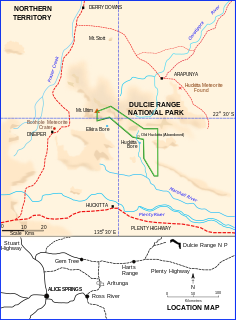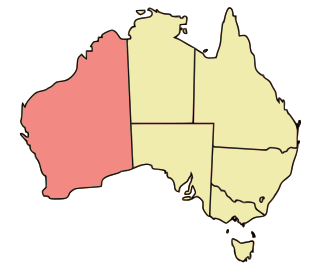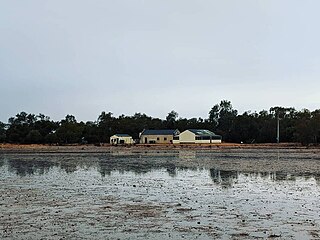Related Research Articles

Dulcie Range is a national park in the Northern Territory of Australia, 220 km north-east of Alice Springs and 1235 km southeast of territorial capital of Darwin. The park lies along the south-western edge of Dulcie Range. It was first declared in 1991 and again in July 2012. A draft Plan of Management was published by the Parks and Wildlife Commission of the Northern Territory in May 2001.
Goongarrie National Park is a national park in Western Australia, 592 km (368 mi) east of Perth and about 94 km (58 mi) north of Kalgoorlie.
Thrushton is a national park in South West Queensland, Australia, 520 km West of Brisbane.

The Top End of Australia's Northern Territory is a geographical region encompassing the northernmost section of the Northern Territory, which aside from the Cape York Peninsula is the northernmost part of the Australian continent. It covers a rather vaguely defined area of about 245,000 km² behind the northern coast from the Northern Territory capital of Darwin across to Arnhem Land with the Indian Ocean on the west, the Arafura Sea to the north, and the Gulf of Carpentaria to the east, and with the almost waterless semi-arid interior of Australia to the south, beyond the huge Kakadu National Park.

Acacia aneura, commonly known as mulga or true mulga, is a shrub or small tree native to arid outback areas of Australia. It is the dominant tree in the habitat to which it gives its name (mulga) that occurs across much of inland Australia. Specific regions have been designated the Western Australian mulga shrublands in Western Australia and Mulga Lands in Queensland.
Casula is a suburb of Sydney, in the state of New South Wales, Australia. It is 34 kilometres south-west of the Sydney central business district, in the local government area of the City of Liverpool.
Nullarbor Regional Reserve is a protected area in South Australia located about 300 kilometres west of Ceduna.

Bush Heritage Australia is a non-profit organisation based in Melbourne, Australia, that operates throughout Australia. It was previously known as the Australian Bush Heritage Fund, which is still its legal name. It purchases land, assessed as being of outstanding conservation value, from private owners, to manage as wildlife reserves in perpetuity. It also partners with existing land owners, including Aboriginal groups, to help plan and manage conservation work of important landscapes. It does so to protect endangered species and preserve Australia's biodiversity. By 2020 the organisation was contributing to the protection of 11.3 million hectares on its reserves and partnership lands. There were 6,700 Australian species recorded on its reserves and partnership properties, including 226 threatened species.

Western Australia occupies nearly one third of the Australian continent. Due to the size and the isolation of the state, considerable emphasis has been made of these features; it is the second largest administrative territory in the world, after Yakutia in Russia, despite the fact that Australia is only the sixth largest country in the world by area, and no other regional administrative jurisdiction in the world occupies such a high percentage of a continental land mass. It is also the only first level administrative subdivision to occupy the entire continental coastline in one cardinal direction.

The pied honeyeater is a species of bird in the family of honeyeaters Meliphagidae and the sole species in the genus Certhionyx. This species is also known as the black and white honeyeater or western pied honeyeater.

Mount Gibson Sanctuary is a 1,305-square-kilometre (504 sq mi) nature reserve on the northern edge of the Wheatbelt and the southern margin of uncleared rangeland country, 350 kilometres (220 mi) north-east of Perth in mid-west Western Australia. The nearest large town is Dalwallinu. It is in the Avon-Wheatbelt Bioregion and is owned and managed by the Australian Wildlife Conservancy (AWC).
Pilungah Reserve, formerly Cravens Peak Reserve, is a 233,000 ha (580,000-acre) nature reserve in Central West Queensland, Australia, 135 km (84 mi) south-west of Boulia and 471 km (293 mi) south of Mount Isa. It lies at the northern end of the Simpson Desert and includes parts of the bioregions known as the Simpson-Strezlecki Dunefields and Channel Country. Its western boundary borders the Northern Territory. It is owned by Bush Heritage Australia (BHA).
Charles Darwin Reserve is a nature reserve in Western Australia.

The Coolgardie woodlands is an ecoregion in southern Western Australia. The predominant vegetation is woodlands and mallee scrub. The ecoregion is a transitional zone between the Mediterranean-climate forests, woodlands, and shrublands of Southwest Australia and the deserts and dry scrublands of the Australian interior.
Christopher William Darwin is an environmentalist and nature conservationist who lives in Australia and works on his goal of halting the global mass extinction of species. He is the ambassador of the charity Bush Heritage Australia. He is the great-great-grandson of Charles Darwin.

The Karroun Hill Nature Reserve is a 3097 km2 nature reserve in the Mid West region of Western Australia, about 310 km north-east of Perth.

Mulga Downs Station is a pastoral lease that once operated as a sheep station but is currently operating as a cattle station in Western Australia.

The Mount Wood Station, also known as simply Mt Wood, is a heritage-listed former cattle station that now forms part of the Sturt National Park in Tibooburra in the Unincorporated Far West region of New South Wales, Australia. The cattle station was built between 1890 and 1969. As a national park, the property is owned by the NSW Officer of Environment and Heritage, an agency of the Government of New South Wales. It was added to the New South Wales State Heritage Register on 2 April 1999.

Prospect Nature Reserve is a nature reserve and recreational area that is situated in the western suburbs of Sydney, New South Wales, Australia, which incorporates the Prospect Reservoir, and also features picnic spots, lookouts, walking tracks and BBQ areas within the Australian bush. It is located within the Blacktown City local government area, but is also close to the boundaries of Cumberland Council and the City of Fairfield.

Mulga is a type of habitat composed of woodland or open forest dominated by the mulga tree, Acacia aneura, or similar species of Acacia.
References
- ↑ Department of the Environment. "Introduction to National Ecological Communities endemic to Western Australia" (PDF). Parkes, ACT: Commonwealth of Australia. Retrieved 16 November 2014.
- 1 2 3 Bush Heritage Australia (2007). "The Mulga-Eucalypt line". Charles Darwin Reserve. Bush Heritage Australia. Retrieved 16 November 2014.